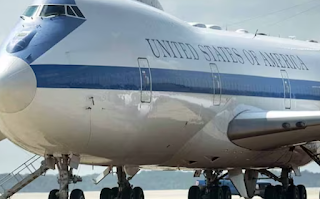To enhance the clarity and context further, here’s a streamlined breakdown of the key themes and implications:
What is the E-4B Nightwatch?
-
A heavily modified Boeing 747-200, officially designated as the National Airborne Operations Center (NAOC).
-
Acts as an airborne Pentagon and is designed to maintain command and control of U.S. military forces in the event of nuclear war or national emergency.
Capabilities and Features
-
EMP-hardened systems, shielded wiring, and absence of windows in critical areas to reduce vulnerability.
-
Can withstand a nuclear blast and operate in a heavily disrupted electromagnetic environment.
-
Equipped with Very Low Frequency (VLF) and High Frequency (HF) systems to communicate with:
-
Submarines
-
ICBM silos
-
Strategic bombers
-
-
Features in-flight refuelling and can stay aloft for several days.
-
Holds over 110 personnel, including military leaders and communication specialists.
-
Does not carry weapons – its role is purely strategic command and control.
Historical Context
-
Developed during the Cold War, part of the Looking Glass program.
-
Maintained 24/7 airborne presence during peak Cold War tensions to ensure retaliation capability.
-
Post-Soviet era saw a shift to ground alert status, but readiness remains high.
9/11 Incident
-
On September 11, 2001, an E-4B was seen circling over Washington, D.C., an extremely rare and restricted event.
-
CNN, NBC, and other outlets reported its presence as “surreal” and deeply unsettling.
-
The U.S. government never fully explained its immediate role that day, leading to speculation and investigation, including in Mark H. Gaffney’s research.
Recent Appearance & Significance (June 2025)
-
Spotted landing at Joint Base Andrews near Washington, amid tensions in West Asia, especially with the Israel-Iran conflict escalating.
-
Triggered renewed social media speculation and strategic analysis.
-
The U.S. Air Force insists such flights are routine; however, their timing often aligns with heightened geopolitical tension, possibly as a signal of readiness or deterrence.
Strategic Implications
-
Serves as a symbol of continuity of government operations in the worst-case scenarios.
-
Its presence in volatile times is often interpreted as a message to adversaries: that U.S. leadership and command will remain intact, no matter the scale of attack.
Looking Ahead
-
Due to rising maintenance costs and aging systems, the fleet of four may see a modernization or replacement in coming years.
-
Proposals for a next-gen command-and-control aircraft are under consideration, although details remain classified.



